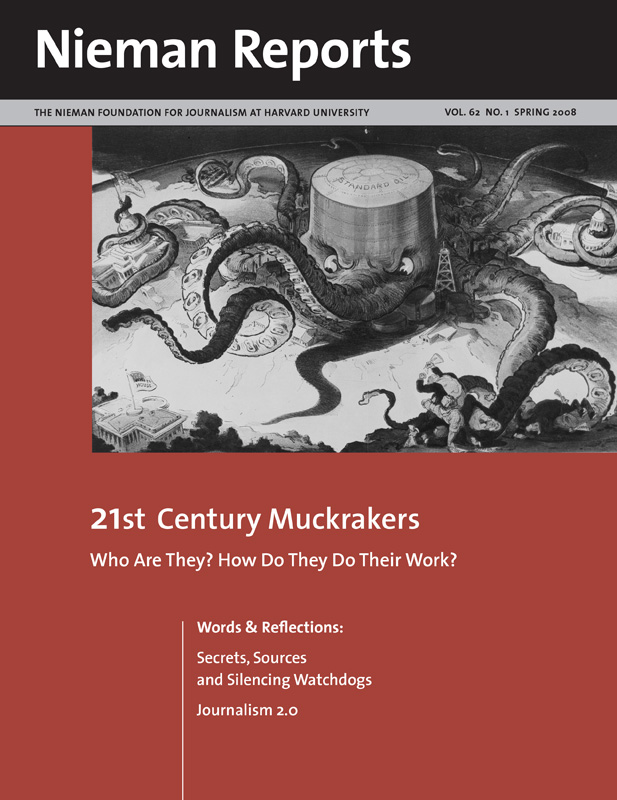The 2006 Pulitzer Prize for National Reporting was awarded to the staffs of The San Diego Union-Tribune and Copley News Service, “with notable work by Marcus Stern and Jerry Kammer,” given in recognition of “their disclosure of bribe-taking that sent former Representative Randy Cunningham to prison in disgrace.” In separate articles that follow, Stern and Kammer describe how, in working on aspects of this story of Congressional corruption, they went about their investigative reporting and built on the work being done by one another.
EDITOR'S NOTE
“The Wrong Stuff: The Extraordinary Saga of Randy ‘Duke’ Cunningham, the Most Corrupt Congressman Ever Caught,” by Marcus Stern, Jerry Kammer, Dean Calbreath, and George E. Condon, Jr., was published by PublicAffairs in 2007.
One of our more valuable sources was Keith Ashdown, the burly and brilliant earmarks’ watchdog at Taxpayers for Common Sense. Ashdown has no equal in the forensic science of tracking earmarks that lobbyists and congressional staffers try to bury like dog bones. It was news coverage of the Cunningham scandal, he says, that made the corruption of earmarks comprehensible to the general public.“Before Cunningham, it was more of a budget wonk thing, it wasn’t anything that grabbed you by the throat and made you pay attention,” he told us during additional reporting we did for the book we wrote about the scandal. “A lot of people thought that earmarking was just something that congressmen are supposed to do.”
The Lewis-Lowery relationship is being probed by federal criminal investigators, who confront the challenge of determining just how far the influence trading can go before it crosses the legal line. Whether or not it is criminal, there is vivid evidence—revealed in the Cunningham saga, the Lewis-Lowery relationship, and the extensive coverage of Jack Abramoff’s schemes—that Congress now often practices governance not envisioned by President Abraham Lincoln at Gettysburg. What we have is government of the lobbyist, by the earmark, for the campaign cash—and the occasional, more explicit bribe of the sort preferred by Randy “Duke” Cunningham.
Jerry Kammer, a 1994 Nieman Fellow, and Marcus Stern each agreed to a buy-out arrangement with Copley News Service in 2007. Kammer hopes to write about immigration, which he first reported on as a correspondent in Mexico in 1986. Stern is working as a media consultant. Information about the book they wrote with two Copley colleagues, based on their reporting about Randy Cunningham, is found at www.thewrongstuff.net.
Combining investigative techniques and technology, a reporter unearths a scandal.
By Marcus Stern
In May 2005, Randy Cunningham was seen by his supporters as a larger-than-life fighter pilot, war hero, and ardent pro-military keeper of the conservative flame. As a Republican member of the U.S. House, he had steered hundreds of millions of federal dollars to his San Diego congressional district and political contributors. The lawmaker who called himself Duke, serving his 16th year in the House, was politically invincible. He could keep his seat for life.
That was then, before Cunningham was disclosed as the most corrupt member of Congress ever caught, both in dollar amount and audacity. As it turned out, he and his cronies had been secretly acquiring boats, mansions, Oriental carpets and other antiques as they traveled by limo and private jet to resorts where they wined, dined and soaked in hot tubs with prostitutes. They paid for their lavish excesses by systematically plundering the military-intelligence budget each year. The former war hero’s corruption earned him the longest prison term ever meted out to a member of Congress—eight years and four months. And it helped put the spotlight on earmarks, the currency of congressional corruption.
The darker side of Cunningham came out thanks to relentless digging by journalists, bloggers and federal investigators. But no suspicions swirled around Cunningham until a newspaper article published on June 12, 2005 showed that a defense contractor named Mitch Wade had purchased Cunningham’s Southern California home at a highly inflated price. The sham home sale paved the way for Cunningham to upgrade from a house to a mansion and Wade’s defense firm to go from having no federal prime contracts to a portfolio exceeding $100 million within two years, according to the article.
As the writer of that story, I’m asked frequently how I got onto it. Most are surprised to learn that no tip was involved. The break came from a time-honored reporting practice: kicking over stones. Or in a digital parlance, what I did might be called “clicking over stones,” since a lot of hunting around in cyberspace is what revealed early on the threads I used to weave this story together.
Early in May 2005, as I sat in my office of the Copley News Service on the 11th floor of the National Press Building, no suspicions swirled around Cunningham. He had taken two trips to Saudi Arabia in the previous year, and I hadn’t believed his explanation then: He said he wanted to improve relations between the Kingdom and the United States. But after a wide-ranging swing through public records, I had nothing to debunk the reason he gave. I decided to do one last thing: to see if the congressman had updated his living accommodations.
An online search of property records found that Cunningham and his wife had purchased a $2.55 million mansion in the pricey neighborhood of Rancho Santa Fe 18 months earlier. That price seemed way beyond the reach of a couple living on the salaries of a lawmaker and a public school administrator. Another search showed that Cunningham had sold his house in Del Mar Heights for $1.67 million—$1.3 million more than he had paid for it about 15 years earlier. Perhaps that put him in position to buy the mansion.
But something else caught my eye: He didn’t sell the house to an individual. He sold it to something called 1523 New Hampshire Ave. LLC. That sounded to me like a Washington, D.C. address. An electronic search found that the buyer was a company registered in the state of Nevada to a man named Mitch Wade. The search also showed that Wade had a second company registered in Nevada: MZM Inc.
I found MZM’s corporate Web site, where I learned it was a fast-growing defense company that had gone from no prime contracts to more than $100 million within the rough time frame of the house sale. Cunningham, as a senior member of the defense appropriations subcommittee, had substantial influence over defense spending. And the defense contractor who bought his Del Mar house for $1.67 million was suddenly swimming in defense contracts.
Next, I looked to see what Wade did with Representative Cunningham’s Del Mar Heights house. Another quick search of property records found that he had put the house right back on the market for roughly the same price he’d paid for it. It languished on the market for eight months before selling at a $700,000 loss. During that same period, San Diego home values had appreciated in double-digits.
Over the next couple of weeks, I was able to review “comps” for houses sold in Del Mar Heights during the period that Cunningham sold the house to Wade. It confirmed that Wade had substantially overpaid.
When I called MZM, a spokesman told me that the company had purchased the house to boost its presence in San Diego. But after the sale went through, the company decided it did not fit their “corporate or security interests.” So Wade put it back on the market without ever actually seeing it. He could not account for the loss in value at a time when home values were exploding upward.
When I called Cunningham, he acknowledged that he had supported Wade’s efforts to get defense contracts, but he insisted that help had nothing to do with the house transaction. When asked what cynics might think, Cunningham said this: “My whole life I’ve lived above board. I’ve never even smoked a marijuana cigarette. I don’t cheat. If a contractor buys me lunch and we meet a second time, I buy the lunch. My whole life has been above board, and so this doesn’t worry me.” Later, he added, “The last thing I would do is get involved in something that, you know, is wrong. And I feel very confident that I haven’t done anything wrong.”
On June 12, 2005, the Union-Tribune in San Diego published the story laying out the details of the home sale along with the explanations offered by the lawmaker and the defense contractor. Five days later, a federal grand jury began issuing subpoenas. Five months later, Cunningham tearfully pleaded guilty to taking more than $2.4 million in bribes. Today, he sits in jail.
Congressional Earmarks: Revealing Who Really Benefits
By Jerry Kammer
Marcus Stern’s explosive story about a defense contractor’s purchase of Duke Cunningham’s home at a grossly inflated price propelled us, in the Copley News Bureau, into a series of investigative stories showing that Cunningham’s corruption, while outrageous, was not truly extraordinary. During the next several months, our reporting unearthed a permissive Capitol Hill culture that unites congressmen, contractors and lobbyists in a sleazy loop of influence buying and selling.
One of that culture’s most prominent features is the earmark, a line item inserted into a spending bill, often with little or no oversight. Earmarks have been around for a long time, and many serve legitimate public purposes. But they didn’t proliferate nor become an open invitation to fraud until the 1990’s, when members of Congress fully recognized their power to raise money and fuel an incumbency protection machine.
Earmarks in defense bills became the currency of Cunningham’s corruption. They were his side of a quid pro quo arrangement that brought him a mansion, Rolls Royce, luxury vacations, a series of boats, and the prostitutes, who last year wrapped up prosecutors’ bribery case against one of Cunningham’s vividly decadent bribing benefactors.
During the past decade, earmarks became central to the legalized bribery of the campaign finance system. In many ways, it is an astonishingly permissive system; it serves sponsors of congressional earmarks by ensuring that their campaign coffers are filled by grateful lobbyists as it responds to the requests of the recipients with largesse. By giving members a personal stake in spending bills, it also helps assure passage. No matter how much wasteful spending the bill contains, a “yes” vote is assured. Earmarks also consume enormous amounts of staff time that could be directed to more legitimate needs.
To peer into this world of influence and affluence, I focused a lot of my reporting on Bill Lowery, a former San Diego congressman and member of the appropriations committee. Lowery, a cynical man who, according to friends, despises the press and wryly notes that his job is guaranteed by the citizen’s right to petition on the Congress, refused to talk.
Lowery had retired from Congress in 1990 after news accounts about his close ties to one of the more corrupt figures in the national savings and loan scandal. As a member of the House Banking Committee, Lowery had enthusiastically supported the S&L deregulation that facilitated that multibillion-dollar plundering of federally insured institutions. After leaving Congress, he immediately became a lobbyist, following the path from Capitol Hill to K Street that has become routine among retiring public servants lured by the financial charms of service to special interests.
Lowery specialized in getting earmarks inserted into spending bills supervised by his close friend from the desert east of Los Angeles, Rep. Jerry Lewis. By 1999, when Lewis became chairman of the defense appropriations subcommittee, Lowery’s satisfied clients were paying him millions of dollars every year. One of his first clients was Brent Wilkes, a former accountant and someone who saw how easily the system could be prostituted. Wilkes bought Cunningham, hired Lowery, contributed liberally to a host of key appropriators, and began getting multimillion dollar earmarks stuffed into spending bills to pay for his services converting government documents into digital format.
My reporting drew on three principal sources of records:
- Lowery’s lobbying disclosure forms revealed his clients and the fees he charged them.
- The conference reports of spending bills helped us compile a partial list of the earmarks these clients received.
- Campaign finance records assembled by the Center for Public Integrity allowed us to tally the contribution checks to political campaigns that were written by Lowery, his associates, and clients.
The most interesting pattern that emerged involved Lewis’s 1999 to 2005 chairmanship of the defense appropriations subcommittee. While Lewis green-lighted hundreds of millions of dollars in earmarks for Wilkes and other Lowery clients, Lowery directed a fundraising machine pumping hundreds of thousands of dollars into Lewis’s campaign coffers.
Lewis didn’t need the money to defend his reliably Republican seat. But in 2004, these funds allowed him to write checks for $650,000 in “excess campaign funds” to the Republican war chest to fund vulnerable incumbents. In this case, money spent on other party members’ races purchased Lewis the best seat at the table. A few months later, Republican leadership awarded him the coveted chairmanship of the full appropriations committee. He called the honor “the highlight of my career.”
Records Reveal, Sources Confirm
Our reporting also revealed a lot about Lewis and Lowery’s exchange of key staff members. We observed that their offices had become “so intermingled that they seem to be extensions of each other.” Two Lewis staffers who had shepherded earmarks into bills for Lowery later joined his lobbying firm, where they earned millions of dollars and became frequent contributors to their former boss.
While I relied heavily on public records, I received valuable help from several human sources. A few Capitol Hill insiders helped us to flesh out the Lowery-Lewis relationship with details about their patronage of Capitol Hill restaurants and Lewis’s role as the best man in Lowery’s second wedding. Having this personal testimony about him added to what I’d gleaned from court records of his two divorces.
Few members of congressional staffs were willing to talk with me for this story, either on or off the record. I received important help, however, from a few former staffers, especially Nathan Facey, who helped me understand the mechanics and the appropriations culture. Facey was disillusioned by his service on Capitol Hill, especially the punch-your-ticket-and-cash-in mentality of congressional staffers who view public service as vocational school for K Street. The opportunistic virus of Lowery’s cynicism has spread its infection across Capitol Hill.
EDITOR'S NOTE
“The Wrong Stuff: The Extraordinary Saga of Randy ‘Duke’ Cunningham, the Most Corrupt Congressman Ever Caught,” by Marcus Stern, Jerry Kammer, Dean Calbreath, and George E. Condon, Jr., was published by PublicAffairs in 2007.
One of our more valuable sources was Keith Ashdown, the burly and brilliant earmarks’ watchdog at Taxpayers for Common Sense. Ashdown has no equal in the forensic science of tracking earmarks that lobbyists and congressional staffers try to bury like dog bones. It was news coverage of the Cunningham scandal, he says, that made the corruption of earmarks comprehensible to the general public.“Before Cunningham, it was more of a budget wonk thing, it wasn’t anything that grabbed you by the throat and made you pay attention,” he told us during additional reporting we did for the book we wrote about the scandal. “A lot of people thought that earmarking was just something that congressmen are supposed to do.”
The Lewis-Lowery relationship is being probed by federal criminal investigators, who confront the challenge of determining just how far the influence trading can go before it crosses the legal line. Whether or not it is criminal, there is vivid evidence—revealed in the Cunningham saga, the Lewis-Lowery relationship, and the extensive coverage of Jack Abramoff’s schemes—that Congress now often practices governance not envisioned by President Abraham Lincoln at Gettysburg. What we have is government of the lobbyist, by the earmark, for the campaign cash—and the occasional, more explicit bribe of the sort preferred by Randy “Duke” Cunningham.
Jerry Kammer, a 1994 Nieman Fellow, and Marcus Stern each agreed to a buy-out arrangement with Copley News Service in 2007. Kammer hopes to write about immigration, which he first reported on as a correspondent in Mexico in 1986. Stern is working as a media consultant. Information about the book they wrote with two Copley colleagues, based on their reporting about Randy Cunningham, is found at www.thewrongstuff.net.



